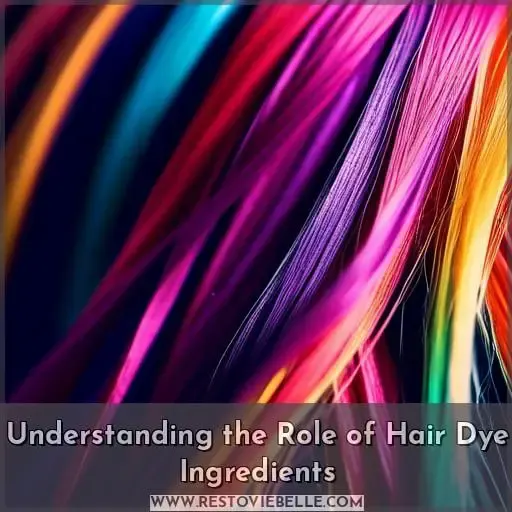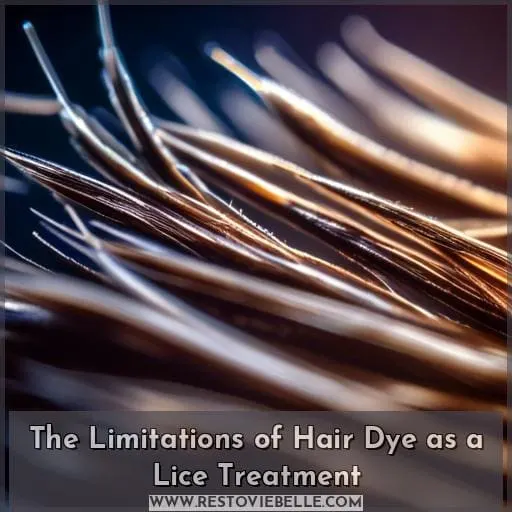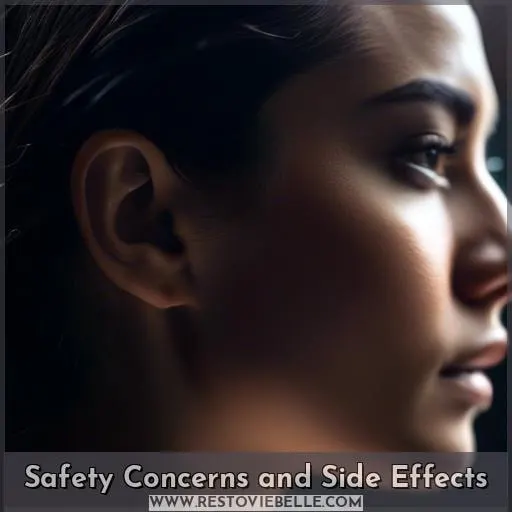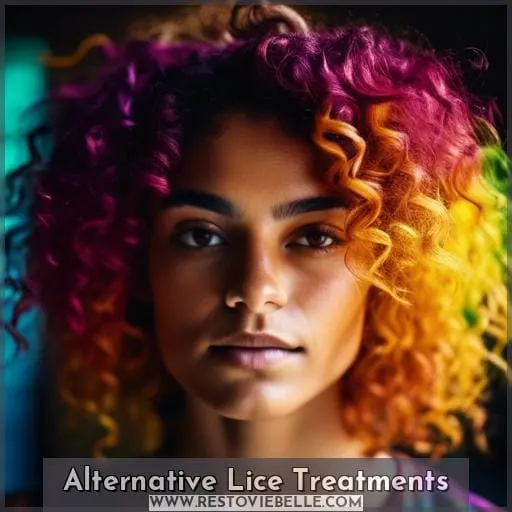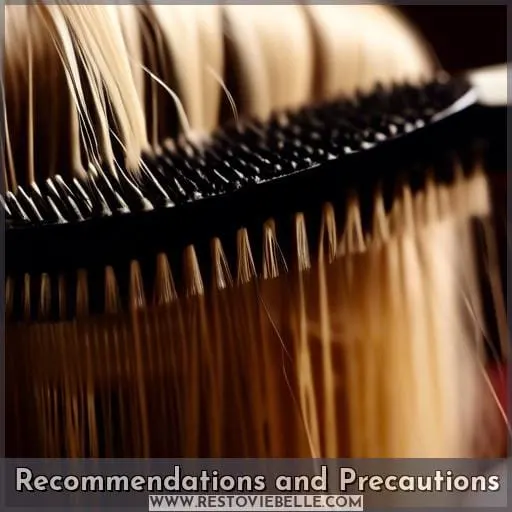This site is supported by our readers. We may earn a commission, at no cost to you, if you purchase through links.
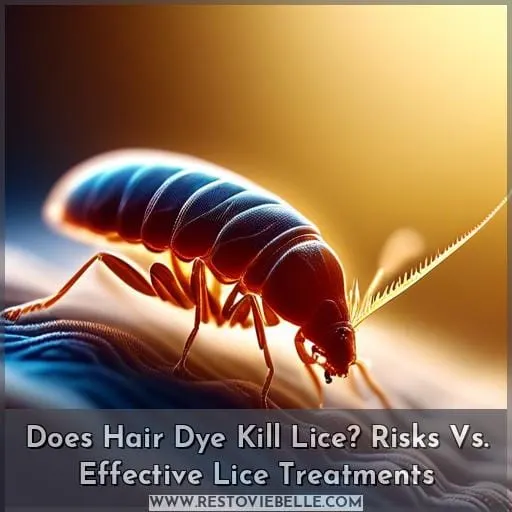 Ironically, while you might reach for hair dye to reinvent your look, it’s unlikely to reinvent your scalp as a lice-free zone. Hair dye’s chemicals, such as ammonia and hydrogen peroxide, may seem potent enough to tackle these pesky parasites, but their effectiveness is largely anecdotal and not scientifically proven.
Ironically, while you might reach for hair dye to reinvent your look, it’s unlikely to reinvent your scalp as a lice-free zone. Hair dye’s chemicals, such as ammonia and hydrogen peroxide, may seem potent enough to tackle these pesky parasites, but their effectiveness is largely anecdotal and not scientifically proven.
If you’re grappling with lice, you’re better off consulting healthcare professionals and considering scientifically-tested treatments, rather than risking potential side effects from an unverified method.
No, hair dye does not effectively kill lice. While hair dye contains chemicals like ammonia and hydrogen peroxide that may kill some lice, it does not eliminate nits (lice eggs) and is not a reliable treatment for lice infestations.
Table Of Contents
- Key Takeaways
- Understanding the Role of Hair Dye Ingredients
- The Limitations of Hair Dye as a Lice Treatment
- Safety Concerns and Side Effects
- Alternative Lice Treatments
- Recommendations and Precautions
- Frequently Asked Questions (FAQs)
- Can hair dye cause an allergic reaction in individuals with a history of skin sensitivities, and how can this be mitigated?
- How does the use of hair dye for lice treatment compare in cost and effectiveness to traditional lice removal methods?
- Are there any environmental concerns associated with using hair dye as a lice treatment, considering the chemicals involved?
- What are the implications of using hair dye for lice treatment on colored or chemically treated hair in terms of maintaining hair health and color?
- Can hair dye be used as a preventative measure against future lice infestations, and what evidence supports this approach?
- Conclusion
Key Takeaways
- Hair dye is not an effective treatment for lice infestations, as it may kill some lice but is ineffective against nits, which can hatch and lead to a new generation of lice.
- The chemicals in hair dye, such as ammonia and hydrogen peroxide, can potentially harm the scalp and hair, leading to irritation, allergic reactions, and damage to the hair.
- Children are particularly vulnerable to the adverse effects of hair dye chemicals, which can cause more severe reactions in their finer and more delicate hair.
- Alternative lice treatments that are safe and effective include wet combing, dimethicone, permethrin 1%, and ivermectin, rather than relying on hair dye or anecdotal evidence.
Understanding the Role of Hair Dye Ingredients
When you’re considering a new hair color, it’s not just about choosing a shade that makes you look like a million bucks. It’s also about understanding what’s going on beneath the surface. Hair dyes are a cocktail of chemicals, and two key players are ammonia and hydrogen peroxide.
Ammonia, an alkali, is like the bouncer at the club, opening up the hair cuticle so the dye can slip in and cozy up to the cortex. But this gatekeeper can be a bit rough, potentially roughing up your hair and causing more greys in the long run.
Hydrogen peroxide, on the other hand, is the life of the party, stripping away your hair’s natural color and letting the new hue take the spotlight. It’s the bleach that clears the canvas for your chosen pigment. But, as with any shindig, there can be a hangover.
Repeated exposure to these chemicals can lead to dry, brittle locks, and there’s a chance they could stir up trouble beyond your scalp, with health risks that might make you think twice.
So, while you’re dreaming of that perfect shade, remember the chemical composition of your dye matters. It’s not just about looking good; it’s about keeping your hair and health in check. And let’s face it, nobody wants a beauty choice to turn into a beastly consequence.
The Limitations of Hair Dye as a Lice Treatment
You might be considering hair dye as a potential remedy for head lice, but it’s important to understand its limitations.
While some believe that the chemicals in hair dye, such as ammonia and hydrogen peroxide, can kill lice, this method hasn’t been scientifically validated and is largely based on anecdotal evidence.
Moreover, hair dye is ineffective against nits, the eggs of lice, which are protected by a hard shell that the dye can’t penetrate.
For a safe and effective lice treatment, it’s essential to use methods that are specifically designed and proven to eliminate both lice and their eggs.
Ineffectiveness Against Nits (lice Eggs)
When you’re battling the tiny but mighty lice, reaching for the hair dye might seem like a clever hack.
Not quite. Here’s the rub: while these potent chemicals can indeed cause a color revolution, they’re no match for the resilience of nits, the lice eggs. These eggs are like little armored tanks, glued to your hair shafts, impervious to the toxicity that hair dye brings to the party.
So, while you might end up with a fabulous new hair color, those nits will remain, ready to hatch a new generation. It’s a classic case of right idea, wrong execution. Plus, let’s not forget the potential discoloration adventure for your scalp and skin.
In the end, it’s like using a sledgehammer to crack a nut—ineffective and overkill.
The Need for Scientific Research to Validate Efficacy
Given the ineffectiveness of hair dye against nits, it’s crucial to underscore the need for scientific research to validate the efficacy of hair dye as a lice treatment. While anecdotal evidence might hint at some success, without rigorous scientific testing, these claims remain speculative at best.
- Research validity ensures that any claims about hair dye killing lice are backed by solid evidence, not just wishful thinking.
- Anecdotal evidence can be misleading. Without scientific scrutiny, it’s hard to differentiate between a fluke and a reliable treatment method.
- Alternative options that have undergone scientific testing offer a safer, more reliable route for lice management, steering clear of the guesswork associated with unproven methods.
In the quest for effective lice treatments, it’s paramount to lean on scientifically-tested methods rather than anecdotal tales.
Safety Concerns and Side Effects
When considering hair dye as a lice treatment, it’s important to be aware of the potential risks to your scalp and skin.
Hair dye contains chemicals like ammonia and hydrogen peroxide, which can be harsh and may kill some lice but aren’t effective against lice eggs or nits.
Moreover, children are particularly vulnerable to the adverse effects of these chemicals, as their scalp and hair may be more sensitive, increasing the risk of irritation and allergic reactions.
Potential Risks of Using Hair Dye on the Scalp and Skin
When you’re considering using hair dye, it’s like opening Pandora’s box on your scalp—full of surprises, not all of them pleasant. Let’s dive into the nitty-gritty of what might happen when those vibrant or sultry shades seep into your skin and scalp.
Imagine your scalp throwing a fit, red and fuming, or your skin absorbing those chemicals like a sponge left in a puddle. It’s not just about changing your hair color; it’s a full-on chemistry experiment happening atop your head.
Here’s a quick rundown of what you might encounter:
| Risk | Symptom | Consequence |
|---|---|---|
| Scalp irritation | Redness, itching | Discomfort, damage |
| Skin absorption | – | Systemic effects |
| Allergic reactions | Swelling, rash | Severe discomfort |
| Scalp damage | Dryness, breakage | Hair health issues |
| Eye damage | Pain, vision issues | Urgent medical care needed |
Specific Dangers for Children Using Hair Dye as a Lice Treatment
When considering hair dye as a lice treatment for children, it’s crucial to weigh the risks.
-
Chemical Exposure: Hair dye contains chemicals like ammonia and hydrogen peroxide, which can be harsh on anyone’s scalp, especially a child’s. Their skin is more delicate, increasing the risk of chemical burns or severe scalp irritation.
-
Allergic Reactions: Kids are more susceptible to developing allergic reactions, which can range from mild itching to severe swelling and even anaphylactic shock. Always patch test before full application, but remember, children’s skin is more reactive.
-
Developmental Concerns: Repeated exposure to the potent chemicals in hair dyes may pose unknown risks to a child’s development. Their bodies are still growing, and introducing harsh chemicals might’ve unforeseen consequences on their health.
In essence, while you’re aiming to tackle lice, using hair dye on children could open a Pandora’s box of health issues.
Alternative Lice Treatments
When exploring alternative lice treatments, it’s crucial to weigh the scientifically-tested methods against anecdotal ones. Using hair dye, which contains chemicals like peroxide or ammonia that may kill lice, is not a recommended or effective method for eradicating an infestation.
Scientifically-backed treatments, including over-the-counter shampoos with permethrin or prescription lotions, offer a more reliable approach to tackling both lice and their eggs.
Presentation of Scientifically-tested Lice Treatments
After diving into the murky waters of hair dye’s potential risks, let’s clear the air with some scientifically-backed lice treatments. You’re not alone in this itchy scenario, and there’s no need to resort to old wives’ tales or unproven methods.
Let’s comb through the evidence and find solutions that won’t leave you scratching your head in frustration.
Here’s a quick glance at some of the top contenders in the battle against these pesky parasites:
| Treatment | Effectiveness | Safety |
|---|---|---|
| Wet Combing | Time-consuming but effective | Safe for all ages |
| Dimethicone | Highly effective by suffocating lice | Very safe, with minimal side effects |
| Permethrin 1% | Effective, but resistance is growing | Generally safe, but may cause scalp irritation |
| Ivermectin | Highly effective in resistant cases | Safe, but prescription required |
Comparison With the Anecdotal Approach of Using Hair Dye
While scientifically-tested lice treatments offer a clear, evidence-based approach to tackling these pesky parasites, the anecdotal method of using hair dye is a whole different kettle of fish.
You might’ve heard tales of hair dye’s miraculous lice-zapping powers, but let’s dive into the nitty-gritty. The dye ingredients, with their complex chemical composition, might show some potential in the battle against adult lice, thanks to their toxicity.
However, it’s a double-edged sword. These same chemicals can wreak havoc on your scalp, leading to skin irritation, hair damage, and a whole host of other not-so-fun side effects.
And let’s not forget, while you’re giving your hair that fabulous new shade, those nits (lice eggs) are likely kicking back, unaffected and ready to hatch. So, before you reach for the dye, remember, it’s not just about changing your hair color; it’s about weighing the risks against the potential (and not guaranteed) rewards.
Recommendations and Precautions
When considering using hair dye as a method to combat lice, it’s crucial to approach this option with caution and prioritize safety.
Consulting with healthcare professionals before attempting to manage lice with hair dye is highly recommended, as they can provide guidance on effective and safe treatments.
While anecdotal evidence suggests that the chemicals in hair dye, such as ammonia and hydrogen peroxide, may kill lice, it’s important to remember that these substances aren’t likely to eliminate nits and can pose risks if not used properly.
Advising Caution When Considering Hair Dye for Lice
As you ponder the idea of using hair dye to tackle lice, it’s crucial to tread carefully. While the allure of a quick fix is tempting, remember that hair dye ingredients aren’t child’s play.
These concoctions are designed with dye absorption rates in mind, not parasite extermination. The scalp’s vulnerability to these chemicals, especially in youngsters, can’t be overstated. Imagine slathering your head with substances that could potentially irritate or harm, all in the pursuit of lice liberation.
It’s a bit like using a sledgehammer to crack a nut—overkill and risky. So, before you dive into the dye, pause and consider the implications.
Encouraging Consultation With Healthcare Professionals for Lice Management
When it comes to managing lice, it’s wise to seek professional advice. Certified practitioners have the medical guidance and expert opinion necessary to navigate this itchy issue.
They’re equipped with the latest on scientifically-tested treatments, far from the anecdotal tales of hair dye heroics.
They’ll steer you clear of potential missteps and ensure you’re not scratching your head over what to do next.
Frequently Asked Questions (FAQs)
Can hair dye cause an allergic reaction in individuals with a history of skin sensitivities, and how can this be mitigated?
Yes, hair dye can cause allergic reactions, especially in those with skin sensitivities.
To mitigate, always perform a patch test 48 hours prior and follow the product’s safety instructions.
How does the use of hair dye for lice treatment compare in cost and effectiveness to traditional lice removal methods?
Hair dye isn’t a silver bullet for lice. It’s like comparing apples and oranges when stacked against tried-and-true lice treatments.
While traditional methods like wet combing show a 53% success rate initially, hair dye’s effectiveness isn’t well-documented scientifically.
Plus, the cost of professional lice removal can be steep. In-home services average $450 for a family of four.
Are there any environmental concerns associated with using hair dye as a lice treatment, considering the chemicals involved?
Using hair dye as a lice treatment raises environmental concerns due to the chemicals involved.
It’s crucial to consider safer, more sustainable options for both health and the planet.
What are the implications of using hair dye for lice treatment on colored or chemically treated hair in terms of maintaining hair health and color?
Using hair dye on colored or chemically treated hair as a lice treatment can be a double-edged sword.
Plus, mixing chemicals can turn your hair health and color into a science experiment gone wrong.
Can hair dye be used as a preventative measure against future lice infestations, and what evidence supports this approach?
Hair dye isn’t a reliable lice prevention method. While it may kill some lice due to harsh chemicals like ammonia and hydrogen peroxide, it won’t stop nits from hatching or prevent future infestations.
Conclusion
Venturing into the world of hair dye as a lice treatment is akin to using a band-aid to fix a leaky roof—it might cover the problem temporarily, but it doesn’t address the root cause.
While hair dye contains chemicals like ammonia and hydrogen peroxide, which may kill some lice, it falls short of eliminating nits, the lice eggs that are the cornerstone of infestation continuity. This method’s effectiveness remains largely anecdotal, lacking the scientific backing necessary to deem it a reliable solution.
Moreover, the potential risks and side effects, especially for children, highlight the importance of pursuing safer, scientifically-tested treatments. Consulting healthcare professionals for lice management ensures a thorough and safe approach, steering clear of the pitfalls associated with unverified methods like hair dye.
In the battle against lice, it’s crucial to prioritize treatments that are both effective and safe, ensuring peace of mind and a truly lice-free outcome.
